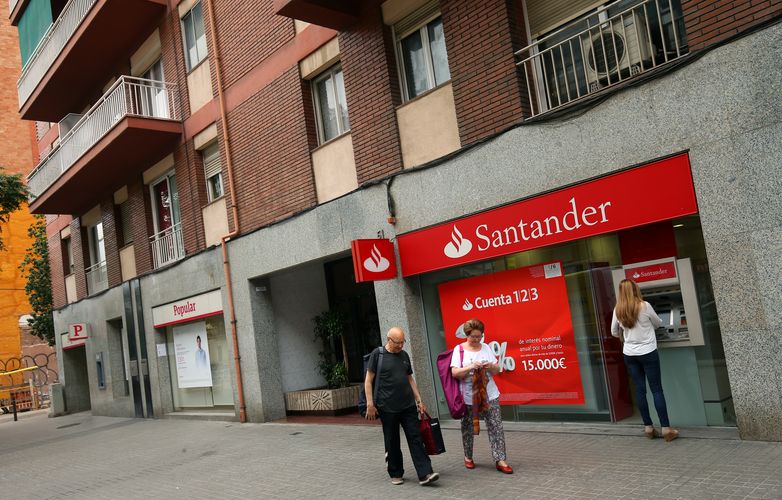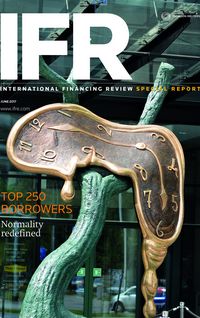The Spanish lender has pulled out the stops as it seeks to meet TLAC targets.
At the start of 2017, Banco Santander’s mission to build up its regulatory capital buffers moved up a gear when the Spanish banking group stole a march on its local regulator and unveiled a two-year plan to issue up to €57bn of debt specifically aimed at complying with new rules covering Total Loss-Absorbing Capital.
In January, the bank convened investor meetings at which it spelled out its plans to issue the debt from its Madrid-based parent, as well as from its three main subsidiaries – Santander UK, Banco Santander USA and Santander Consumer Finance.
The plans amounted to a pre-emptive strike. The European Commission had unveiled its draft regulations regarding TLAC in late 2016 but only France has transposed it into domestic law, paving the way for its banks to issue senior non-preferred bonds. By contrast, the legislation does not apply to the rest of Europe until at least the second half of 2017.
Santander could not afford to wait that long. Given its status as a G-SIFI, it is subject to the Financial Stability Board’s rules on TLAC and must hold 16% of its risk-weighted assets in eligible bonds by 2019. So it created ‘second ranking senior notes’ - the equivalent of TLAC-eligible senior non-preferred bonds - that enabled it to press ahead with its plans without having to wait for the final green light from the authorities.
Two weeks after announcing the strategy update, Banco Santander became the first peripheral issuer to raise non-preferred debt, when it hit the market on January 26 with a debut €1.5bn five-year trade that priced at swaps plus 120bp, the tight end of the 120bp–125bp guidance range and compared with initial price thoughts of 135bp.
The deal attracted over €4bn of demand and the order book remained intact through to final pricing. The bonds have steadily tightened and were trading at mid-swaps plus 85bp on June 6.
“These are some of the best funding conditions we’ve seen across the banking sector, which was another reason to come to the market early,” said one syndicate source.
Santander’s eagerness to hit the ground running was helped by a surge in demand for bank paper following a tightening in spreads that began during the fourth quarter of 2016. This provided a much needed boost in providing market access to Europe’s lenders, and Santander has not looked back since.
“In terms of pricing, it’s challenging to place a new security, but we were lucky to have a number of other names in the market. The French banks were a good point of reference,” a spokesperson for Santander said.
On April 4, Santander followed its inaugural euro senior non-preferred deal with a debut in US dollars, finding strong demand from investors for the loss-absorbing debt format. A US$1bn five-year tranche priced at Treasuries plus 168bp, a US$500m five-year FRN at three-month Libor plus 156bp and a US$1bn 10-year at 200bp over Treasuries, at the tight end of price guidance. The final order book reached US$6.2bn, with more than 500 individual orders.
“It made sense for us to make our debut in our home market and a five-year seemed like a good place to start, then it was logical to move to a big market like dollars to develop the curve. Now we have benchmarks in both major currencies that serve as clear liquid references for our investors,” the spokesperson said.
Clarity key
The bank followed the same approach it took in Europe, conducting a roadshow and series of one-on-one investor meetings across the US in which it explained its plans. Clarity was the watchword, with the bank avoiding using the callable structures that have been particularly popular in the dollar market.
“We don’t have 100% clarity on how the calls will be treated. We know the callable features are well established in the US and the UK and we understand the dynamics of those products, but, for the time being, we want to keep our issuance simple and straightforward,” the spokesperson said.
In the strategy update, Santander, which operates a decentralised funding model of autonomous subsidiaries, said it planned to issue around €20bn of senior non-preferred paper in 2017, with €12bn to €14bn coming through its main parent, and another €2bn-€3bn apiece from its subsidiaries Santander UK and Santander Holdings USA. It also said Santander Consumer Finance will issue senior non-preferred in 2018.
It is well on the way to achieving that target. Between January and April 2017, the group issued €12.8bn of debt across euros, US dollars and sterling, of which €8.8bn is TLAC-eligible. Of that, €7bn was issued by the parent, with the rest coming from Santander UK and USA.
On January 4, Santander UK printed a US$1bn five-year senior holdco deal, then four days followed it up with a sterling debut. Then, on March 30, as the UK government began the formal process of withdrawing from the European Union by triggering Article 50, Santander UK ended a nearly two-year absence from the sterling AT1 market. The favourable market backdrop along with the relatively small size – the UK entity opened books on a £500m deal - allowed pricing to be pulled in. The deal was Santander UK’s first AT1 since making its debut in June 2015. Santander USA tapped the market in January with a senior holdco trade.
“We follow a multiple-point-of-entry strategy in which entities need to issue separately. We needed to coordinate our approach to the market and it was important to keep investors well informed about our plans. We have been extremely well coordinated so as not to over-crowd the market,” the spokesperson said.
Santander also diversified its funding by raising around €1.1bn-equivalent in a dozen or so private deals, which have mainly been in euros, with some yen transactions.
“We need to touch every maturity between fives and 10s and look for pockets of demand,” the spokesperson said. “The more we diversify away from the big benchmark deals into other maturities, the more beneficial it is for everyone. The good thing is that investors have a clear point of reference in terms of the benchmark transactions, so they can reference those public deals in order to invest in the private transactions.”
The banks is also targeting €3bn TLAC-eligible hybrid instruments, issuing both Tier 2 and AT1 paper as part of plans to reach a of a total group capital ratio of 14.5% by the end of 2018.
In January 2017, it helped reopen the Tier 2 market in euros for Southern European issuers, then printed a €750m AT1. That leaves the parent with €1.25bn to go between now and the end of the year.
“We still have some way to go, mainly in the AT1 market, and we will approach in the second half of the year again. We are pretty sensitive to the state of the market and will be monitoring that in next few months,” said the spokesperson.
The bank was last in the Tier 2 market during the second quarter of 2016, while it had stayed away from the AT1 market for two years. In 2016, the group issued €31bn across seven geographic entities, with the bulk coming from UK the Spain. Highlights included a US$1.5bn five-year from Santander UK on August 2, its first Yankee since the UK’s vote to leave the European Union.
To see the digital version of this special report, please click here
To purchase printed copies or a PDF of this report, please email gloria.balbastro@tr.com




